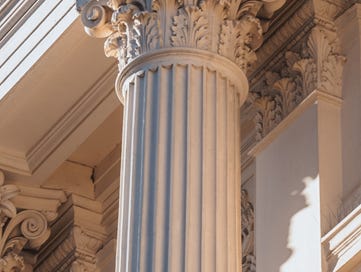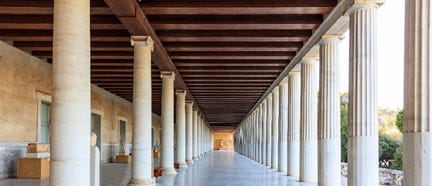Comparing Rectangular and Circular Columns
On the Basis of Load Carrying Capacity, Alignment, Formwork and Much More
Introduction
A column is a vertical element which carries loads from connected beams to the foundation below the ground surface. Column is a compression member, which means it is designed primarily to resist compressive forces. However, consideration of lateral loads of wind and earthquake, and sometimes soil pressure, may also be needed while designing columns. Pillar, post and stanchion are some terms which are interchangeably used for columns. A strut is a compression member forming a part of a larger structure (such as a truss), whereas a short compression member is called a pedestal. A column supporting bridge spans is called as a pier.
A single column can be connected to a number of beams, which in turn support multiple floor slabs. Hence, columns must be designed and constructed very safely, as their safety is indispensable for the overall safety of any structure. While columns are generally constructed for structural purposes, that is to carry the weight of floors and beams, in some cases columns are erected exclusively for visual purpose, that is as aesthetic elements.
Shapes of Columns
Columns can be provided in a number of shapes. The shape to be provided depends on a number of factors, such as architecture of the building, whether the column is placed along walls or freestanding, load to be carried, economy and so on. The choice of shape is also influenced by the construction material used, such as reinforced cement concrete (RCC), steel or timber. Rectangular, circular, L-shape and T-shape are most commonly used in RCC structures.
Rectangular columns are most commonly used in normal RCC buildings because they can easily be moulded and they offer better alignment with partition walls. On the other hand, where columns are needed for decorative or monumental effect, circular shape is almost exclusively used. There are quite a few differences between circular and rectangular columns. Let us go through these differences and better understand their suitability.
Aesthetics

Aesthetics is concerned with how a structure or space appears and feels. The aesthetic nature of circular columns makes them the preferred choice in public buildings such as shopping malls, educational institutes and offices. Some buildings such as malls, museums and airports even utilize abstract column shapes to spawn ornamental effect depending on the context of the building.

Load Carrying Capacity and Stress Distribution
In circular columns, generally helical transverse bars are used. As per IS 456:2000*, the load carrying capacity of columns with helical tie bars is 5% more than those with ordinary lateral ties (subject to some conditions). This is because the continuous spiral provides better confinement of longitudinal bars. Thus, a circular column with spiral reinforcement will have higher load carrying capacity than a rectangular column of the same area with ordinary lateral ties.

Moreover, in rectangular columns, stress tends to concentrate at the sharp corners. On the other hand, circular columns show better stress distribution as there are no corners in circles. This also makes the circular shape advantageous for use in bridge piers over water bodies, as the wave impact of moving water is minimum for circular shape.

Area and Alignment with Walls
Area required for a column can basically be calculated from the load to be carried. Based on this, dimensions (side lengths/ diameter) can be decided. For a circle having diameter same as the side of a square, the area of the circular section will be moderately less (to be precise, it will be 78.54% of area of the square). Thus, in places where plan dimensions are limited, due to lesser area of circle, more reinforcement will be needed in the circular column to resist the same load.
In terms of alignment, rectangular columns are advantageous as they can be placed flush with the wall. Providing circular columns in corners of a room may result in wastage of space as in this case the walls will lack right angled edges. This means that placing furniture in a corner of the room will result in some corner space being wasted. This is the primary reason rectangular columns are the natural choice for residential buildings.
Formwork, Reinforcement and Finishing
Formwork is the temporary mould used to support concrete until it hardens sufficiently to carry its self-weight. Circle has the least perimeter among all regular polygons for a given area. This results in requirement of lesser formwork material for the same area of column. However, it is difficult to produce formwork of circular shape, especially to ensure the accuracy of shape through the height of the column.
Moreover, circular formwork of a certain diameter cannot be adjusted for different sizes. Thus, formwork can turn out to be expensive for smaller sized circular columns and for less number of repetitions. On the other hand, by using rectangular shape, a single formwork can be assembled and used repetitively for multiple sizes.
As per IS 456, minimum number of reinforcement bars for rectangular columns is 4, while it is 6 for circular ones. So, more number of bars need to be provided in circular columns. However, lesser diameter bars can be utilized to provide the same total area of reinforcement.
Also, finishing work, such as plastering, painting and tiling, can turn out to be somewhat expensive for a circular column. This is because better quality of workmanship will be needed for finishing a curved surface as compared to that for plane surfaces. Also, in case of tile finish, tiles will need to be tailor-made to fit the size of the column.
Use of Columns for Aesthetic Purposes
As discussed above, columns are often used for their decorative appeal. Aesthetic utility of columns can be achieved in a number of ways, such as by providing extraordinary shapes or heights of columns or by providing them in the form of colonnade or portico.

Tall, circular columns evoke feelings of aspiration, stability and authority. This is the reason why circular columns have been used as an aesthetic element in many historical structures, notably in Greek architecture. This practice is continuing even in the modern age, with many remarkable buildings being surrounded with columns for monumental effect. Some notable buildings in India which have used columns for such purposes are pictured below.



Conclusion
From the above discussion, the following summary can be drawn:
1. Circular columns are preferred for aesthetic purpose and hence are widely used to ornament important buildings.
2. Circular columns with helical bars have slightly higher load carrying capacity than rectangular columns of the same area with ordinarily spaced lateral ties.
3. Stress is uniformly distributed in circular columns, unlike in rectangular ones, where stress gets concentrated at the corners.
4. Area of a circle having diameter same as the side of a square will be less. Hence in places with limited space, rectangular columns are advantageous.
5. Rectangular columns can be easily aligned with walls, preventing wastage of interior space.
6. Formwork for circular columns turns out to be uneconomical due to difficulty in achieving accuracy of shape and because a form of single size cannot be adjusted for other sizes.
7. More number of longitudinal bars need to be provided in circular columns as compared to rectangular ones.
8. Finishing work will be expensive for circular columns due to requirement of better workmanship and special materials.
*IS 456:2000 "Plain and Reinforced Concrete- Code of Practice” is a standard document published by Bureau of Indian Standards (BIS) which contains regulations and guidelines on various aspects of design and construction of concrete structures.












